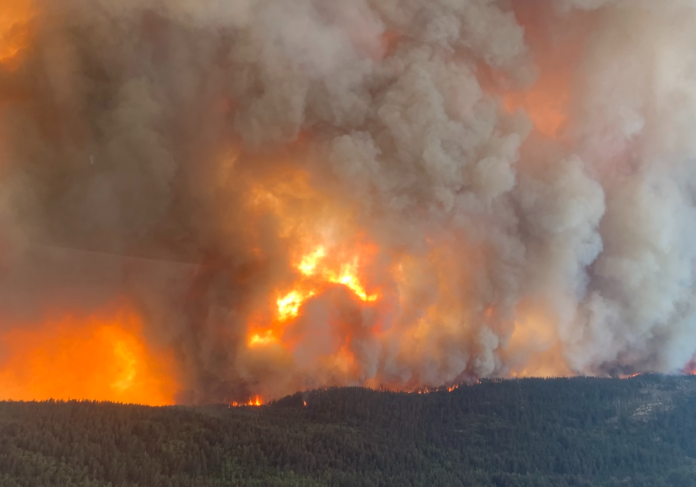Last Thursday the wildfire situation in BC went from bad to worse after a cold front moved in from the west and brought with it strong winds, fanning the flames across the province.
As of Saturday, August 19th, a provincial state of emergency was declared by Premier David Eby and Bowinn Ma, BC’s Minister of Emergency Management and Climate Readiness.
When the statement was issued, over 35,000 people had been put under an evacuation order in the province with an additional 30,000 being on evacuation alert.
The state of emergency order was established to ensure temporary accommodations like hotels and motels could be accessed by evacuees who need them and to limit travel through corridors most heavily impacted by the wildfires.
Saturday’s forecast brought more wind to the fire stricken regions of BC pushing the perimeters of these fires with BC Wildfire Service crews working around the clock to notify residents they had to leave their homes while also battling the raging fires.
Through all this, those impacted by the wildfire evacuation orders have had a difficult time accessing information about the fires surrounding them due to the Canadian government’s Bill C-18, colloquially known as the Online News Act.
Meta is now coming under mass scrutiny for limiting people’s access to news stories on their platforms, especially given the current state of emergency.
As of this publication, there are 382 active wildfires burning throughout BC.
Here’s a breakdown of what is going on in each of the BC Wildfire Service’s zones:
Coastal region
BC’s coastal regions are dealing with many out of control fires which are largely surrounding First Nations and rural communities with no urban evacuation orders currently in place.
East of Bella Coola there is a massive wildfire on Trumpeter Mountain which is over 4,600 hectares in size and to the north there are several wildfires being tackled by BC Wildfire Service, but those are much smaller in size.
On Vancouver Island, there are currently 13 wildfires, most of which are being held which means they are no longer growing and perimeters have been controlled successfully.
However, one major change has taken place with the wildfires in Strathcona Provincial Park. There were a series of wildfires labelled as ‘moniter only’ by BC Wildfire Service that were discovered on August 6th. Now, some of those fires have merged into a much larger wildfire around Mount Con Reid which is now burning over 1,600 hectares and remains out of control.
BC Wildfire Service continues to list the five fires in Strathcona Provincial Park as monitor only as of this publication as they deal with so many other fires and this particular blaze doesn’t have any infrastructure or homes around it.
Kamploops region
The Kamloops zone is definitely the most impacted by the weather shift that amplified the wildfire situation last week.
They have numerous evacuation orders and alerts in place with thousands displaced caused by nine major fires labelled as ‘fires of note’ by the BC Wildfire Service meaning they are of risk to public safety.
The McDougall Creek wildfire has merged with two other massive blazes and has been encroaching on West Kelowna and the Okanogan since last Thursday and continues to push closer, despite the best efforts of BC Wildfire Service crews and local firefighters.
There are 78 firefighters and 11 operational staff battling these fires with the help of 15 helicopters, an incident management team and structural protection crews.
Environment Canada’s Air Quality Index lists the Central Okanagan region as having a 10+ rating which is the highest it can go. By Tuesday, the air quality forecast predicts that the risk level will go from very high to moderate as winds carry smoke away from the area.
The Downton Lake and Casper Creek fires have grown substantially to over 6,800 hectares and 9,100 hectares respectfully.
Slightly southeast of those fires, a blaze on Stein Mountain has developed and is threatening some surrounding communities while the nearby Kookipi wildfire has grown to over 10,000 hectares in size.
The Kookipi wildfire has 105 fire crew personnel, one helicopter, 13 pieces of heavy duty machinery, an incident management team and structure protection all working to put an end to the blaze.
Just south of the City of Kamloops, the Rossmoore Lake wildfire is approaching urban areas while crews continue to battle the fires.
It is over 7,800 hectares in size but thus far, no Kamloops locals have had to evacuate their homes; however, some rural communities south of Kamloops have had to evacuate.
South of Penticton there are two massive wildfires near the Washington Border which have grown substantially. The Crater Creek wildfire is over 44,000 hectares in size and the Upper Park Rill fire is up to almost 2,000 hectares. Both of these have caused evacuation orders.
Prince George region
This area has been the most impacted since this year’s wildfire season began, but because of how sparsely populated the more northeast regions of the province are, there has been far less risk to urban communities.
The Donnie Creek wildfire remains the largest in the province at over 580,000 hectares now, one of the largest wildfires in BC history.
Further north there are several fires larger than 10,000 hectares along the Alberta and Northwest Territories borders there are three smaller fires of note which could cause additional evacuations should they not be held off west of Prince George.
The Greer Creek wildfire, Great Beaver Lake wildfire and Whitefish Lake wildfire are all listed as fires of note but have numerous BC Wildfire Service crewmembers attacking their perimeters.
Southeast region
The Southwest region of BC Wildfire Service’s zones is one of the smallest, yet sees a lot of action through the Rocky Mountains and near the Washington border.
Nelson, Cranbrook, Grand Forks, Fernie Kimberly and Revelstoke all fall within this region and have luckily not been subject to many evacuation orders or alerts thus far this season.
As of this publication, there is just one fire of note, the Horsethief Creek wildfire, which is just 10 kilometres from Invermere. It is around 4,000 hectares in size but thus far has not been cause for any evacuations.
Caribou and Northwest regions
Both of these regions have been the least impacted thus far by fires although they both have had several wildfires emerge and be put out or held off by BC Wildfire Service crews.
No fires of note are currently burning in either region and most of the blazes taking place have been labelled at being held by BC Wildfire Service.
All corners of BC have been impacted by this potentially record-setting wildfire season and it could still get worse.
In 2021, BC spent a total of over $718 million on its battle with wildfires throughout BC which is around $400 million more than the 10-year average.
The wildfire situation continues to be dire in BC and changes every day. Up to date information on all wildfires can be found through BC Wildfire Service’s website.


